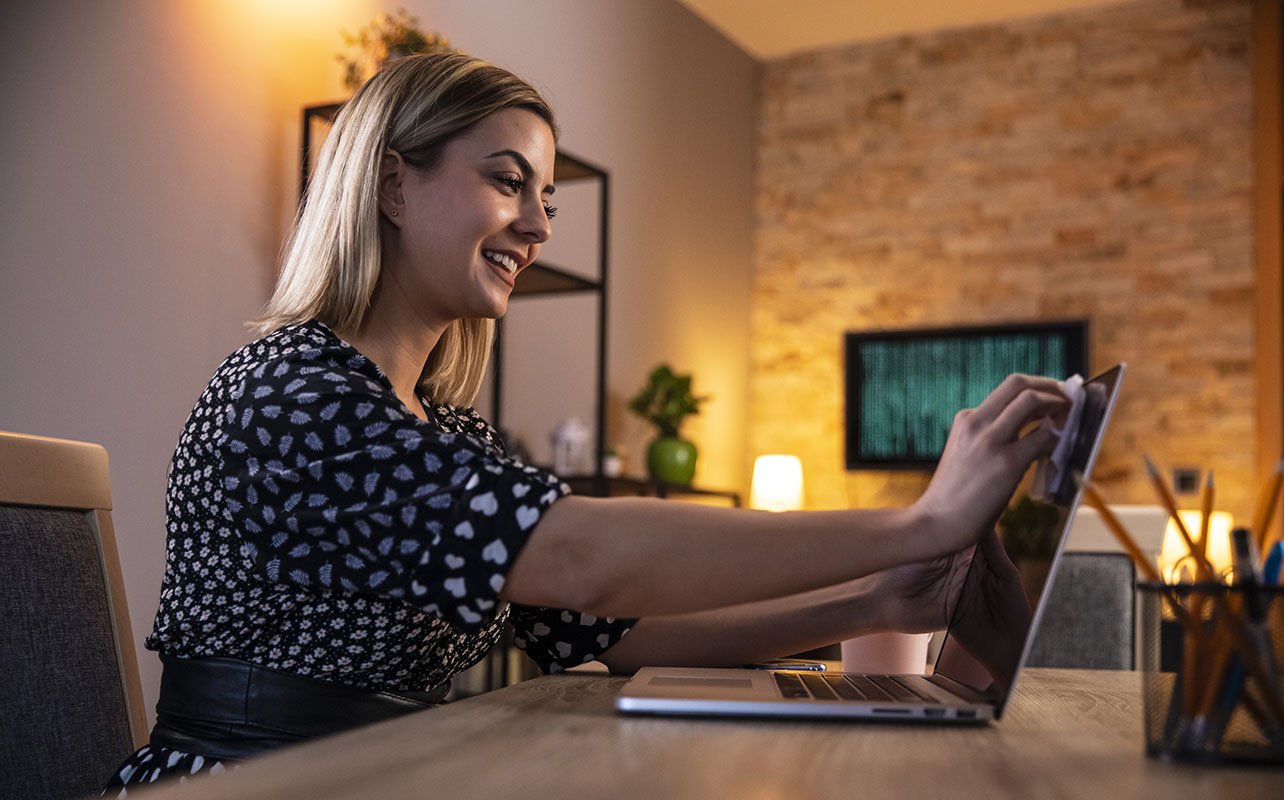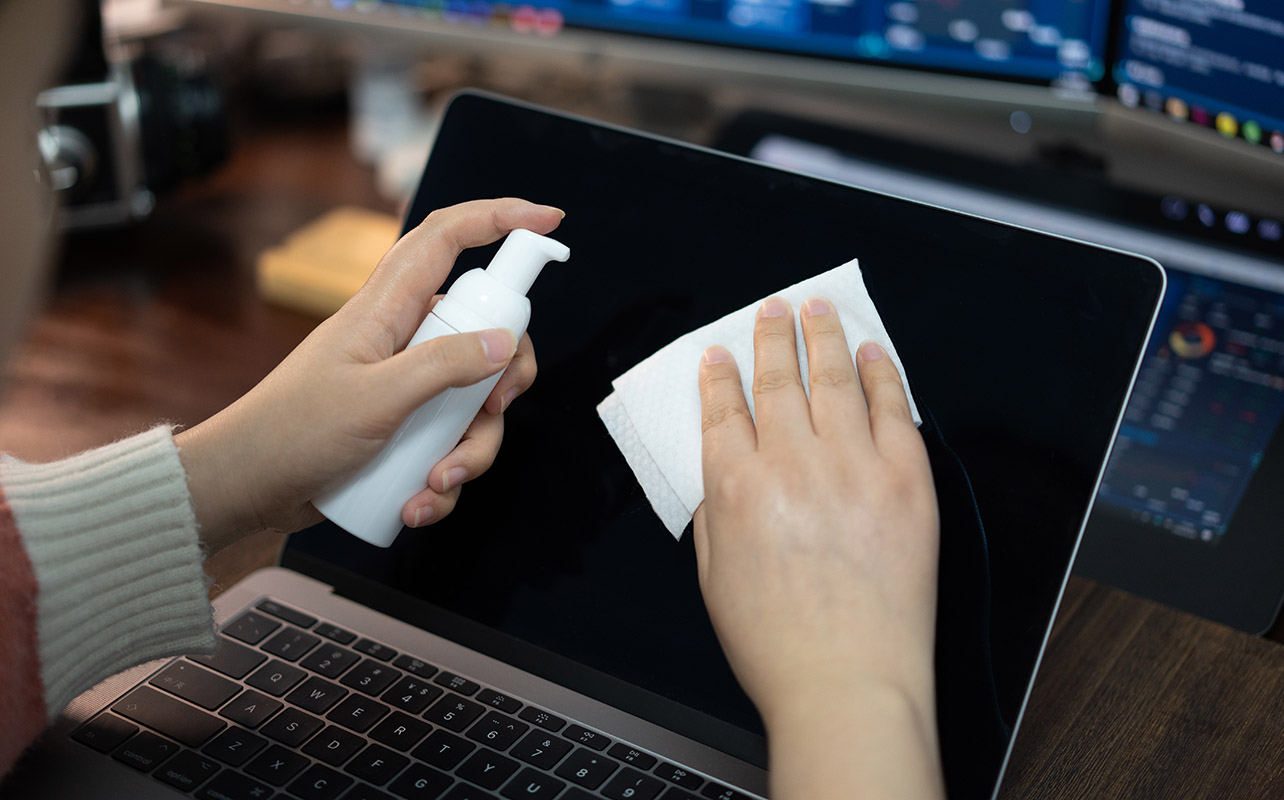
Ever notice how quickly your laptop screen collects fingerprints, dust, and smudges? It’s something we all deal with, but it’s easy to overlook—until it becomes hard to see anything clearly. Cleaning your screen the wrong way, however, can make things worse. In this guide, we’ll walk you through how to clean a laptop screen safely and effectively, recommend safe cleaning products, and highlight common mistakes to avoid so you can keep your screen looking fresh and your laptop in great shape.
What you’ll need to clean a laptop screen
Before starting the cleaning process, gather the necessary materials to avoid damaging your screen. Here’s what you’ll need:
- Microfibre cloth: Soft and lint-free, ideal for gentle cleaning without scratching.
- Distilled water: Free from minerals that can leave streaks or residue on the screen.
- Optional – Screen-safe cleaning solution: Ensure it’s alcohol- and ammonia-free to avoid damaging the protective coating.
- Optional – White vinegar: Can be diluted with distilled water as a natural, non-abrasive cleaner.
- Optional – Compressed air: Helps remove dust from crevices around the screen.
What not to use to clean your laptop screen
- Paper towels, tissues, or rough cloths: These materials can be abrasive and cause micro-scratches on the screen.
- Household cleaners (Windex, bleach, ammonia-based products):These chemicals can strip away the protective anti-glare coating and cause discoloration.
- Excess water or liquid: Spraying liquid directly onto the screen can seep into the edges and cause internal damage.
- Alcohol or acetone-based cleaners: These can deteriorate the screen’s protective layer and cause clouding over time.
How to clean a laptop screen safely
Step 1: Turn off and unplug your laptop for safety
Before cleaning, always power down your laptop and unplug it from any power source. This prevents electrical hazards and allows the screen to cool down. A cool screen makes it easier to spot smudges and dust for a more effective clean.
Step 2: Use a microfibre cloth to remove loose dust
Gently wipe the screen using a dry microfibre cloth in circular motions. This removes loose dust and debris without scratching the surface. Avoid using excessive force, as pressure can damage the screen.
Step 3: Dampen the cloth with a safe cleaning solution
If there are stubborn smudges, slightly dampen a corner of the microfibre cloth with distilled water or a 50/50 mix of distilled water and white vinegar. Remember, the cloth should be damp, not wet—avoid soaking it. Never spray any liquid directly onto the screen.
Step 4: Wipe the screen gently without applying excess pressure
Using the dampened part of the cloth, gently wipe the screen in a circular motion, focusing on areas with smudges or fingerprints. Be patient, and don’t apply excessive pressure, as this could damage the screen or its internal components.
Step 5: Let the screen dry completely
After cleaning, allow the screen to air dry for a few minutes before turning the laptop back on or closing it. This ensures that no moisture seeps into the device, preventing potential damage.
Just like your screen, your laptop’s keyboard also collects dust and grime over time. Learn how to clean your keyboard to keep your entire device in top condition.
Common mistakes to avoid when cleaning a laptop screen

Many people unknowingly make cleaning mistakes that can harm their laptop screens. Here are some key mistakes to avoid:
- Using rough cloths or paper towels: These can leave micro-scratches and lint on the screen.
- Spraying liquid directly on the screen: This can cause moisture to seep into the edges and damage internal components.
- Using strong chemicals like ammonia or bleach: Harsh chemicals can strip the screen’s protective coating and cause discoloration.
- Applying too much pressure while cleaning: Pressing too hard can damage pixels, leading to dark spots or display malfunctions.
- Using alcohol-based solutions: Can dry out and damage the screen’s surface over time.
How often should you clean your laptop screen?
To keep your laptop screen in top condition, clean it regularly. Weekly, give it a light dusting with a dry microfibre cloth to prevent dust buildup. Once a month, perform a deeper clean using a dampened microfibre cloth with distilled water or a screen-safe cleaner. Additionally, if you notice any smudges, streaks, or dirt affecting visibility, clean your screen immediately to avoid permanent marks.
Additional tips for maintaining a clean laptop screen
- Wash your hands before using your laptop to minimize oil and dirt transfer.
- Avoid eating or drinking near your laptop to prevent accidental spills and smudges.
- Store your laptop in a dust-free environment or use a laptop sleeve when not in use.
- Use a keyboard cover to prevent dust and debris from transferring to the screen.
- Keep a microfibre cloth handy for quick touch-ups and dust removal.
Keep your laptop screen spotless and protected
Keeping your laptop screen clean not only improves its clarity but also extends its lifespan and enhances your overall user experience. By following these simple steps and avoiding common cleaning mistakes, you can maintain a spotless and damage-free screen.
Using the right cleaning products is crucial to prevent any harm to your screen, so always opt for gentle, screen-safe solutions. Regular maintenance will help keep your laptop looking as good as new, ensuring the best possible experience with your device.
This article was drafted using AI technology and then reviewed, fact-checked, and revised by a member of our editorial team.





